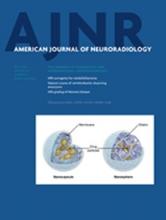Index by author
Yeom, K.W.
- BrainOpen AccessDiffusion-Weighted Imaging with Dual-Echo Echo-Planar Imaging for Better Sensitivity to Acute StrokeS.J. Holdsworth, K.W. Yeom, M.U. Antonucci, J.B. Andre, J. Rosenberg, M. Aksoy, M. Straka, N.J. Fischbein, R. Bammer, M.E. Moseley, G. Zaharchuk and S. SkareAmerican Journal of Neuroradiology July 2014, 35 (7) 1293-1302; DOI: https://doi.org/10.3174/ajnr.A3921
- PediatricsYou have accessHydrocephalus Decreases Arterial Spin-Labeled Cerebral PerfusionK.W. Yeom, R.M. Lober, A. Alexander, S.H. Cheshier and M.S.B. EdwardsAmerican Journal of Neuroradiology July 2014, 35 (7) 1433-1439; DOI: https://doi.org/10.3174/ajnr.A3891
- FELLOWS' JOURNAL CLUBExpedited PublicationOpen AccessMRI Surrogates for Molecular Subgroups of MedulloblastomaS. Perreault, V. Ramaswamy, A.S. Achrol, K. Chao, T.T. Liu, D. Shih, M. Remke, S. Schubert, E. Bouffet, P.G. Fisher, S. Partap, H. Vogel, M.D. Taylor, Y.J. Cho and K.W. YeomAmerican Journal of Neuroradiology July 2014, 35 (7) 1263-1269; DOI: https://doi.org/10.3174/ajnr.A3990
These authors seek to establish the imaging features that would allow classification of medulloblastomas according to their genetic attributes. In nearly 100 tumors they found that groups 3 and 4 occurred predominantly in the fourth ventricle, wingless ones were located in the cerebellar peduncles or CPA region, and sonic hedgehog tumors were present in cerebellar hemispheres. Midline group 4 tumors showed minimal contrast enhancement. Thus, tumor location and contrast-enhancement patterns may be predictive of the molecular subtypes of medulloblastoma.
Yuki, I.
- FELLOWS' JOURNAL CLUBNeurointerventionYou have accessNatural Course of Dissecting Vertebrobasilar Artery Aneurysms without StrokeN. Kobayashi, Y. Murayama, I. Yuki, T. Ishibashi, M. Ebara, H. Arakawa, K. Irie, H. Takao, I. Kajiwara, K. Nishimura, K. Karagiozov and M. UrashimaAmerican Journal of Neuroradiology July 2014, 35 (7) 1371-1375; DOI: https://doi.org/10.3174/ajnr.A3873
More than 100 conservatively managed nonstroke dissecting vertebrobasilar artery aneurysms were followed on average for 3 years. Ninety-seven percent of patients remained clinically unchanged and the 3 patients who deteriorated clinically had aneurysm enlargement. The natural course of these lesions suggests that acute intervention is not always required and close follow-up without antithrombotic therapy is reasonable. Patients with symptoms due to mass effect or aneurysms of >10 mm may require treatment.








